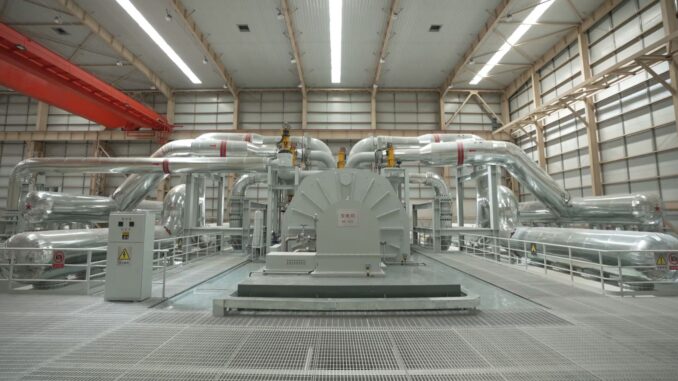
The world’s largest and, more importantly, most efficient clean compressed air energy storage system is up and running, connected to a city power grid in northern China.
The clean energy revolution will require huge amounts of energy storage, to buffer against the intermittent power delivered by solar and wind. Some of that will come in the form of big battery installations – but there’s a huge lithium supply shortage coming that’ll raise the price of lithium-based batteries and make it very tough for Tesla-style operations to handle a big chunk of the work.
China has diversified its efforts, and indeed just this week it switched on the world’s largest flow battery, a 100-MW, 400-MWh vanadium flow battery installed in Dailan that offers relatively low-cost energy storage without using any lithium. But according to Asia Times, China is planning to lean heavily on compressed air energy storage (CAES) as well, to handle nearly a quarter of all the country’s energy storage by 2030.
Now, after several years of development by the Chinese Academy of Sciences, it has connected the world’s first 100-MW advanced CAES system to the grid, ready to begin commercial service in the city of Zhangjiakou in northern China. By designating it as “advanced,” the Academy is distinguishing it from the McIntosh Plant that’s been online since 1991 in Alabama – a 110-MW CAES facility that burns its stored air with natural gas to recover energy, and is thus not a green energy storage solution.
The new Zhangjiakou plant does away with fossil fuels, using advances in supercritical thermal storage, supercritical heat exchange, high-load compression and expansion technologies to boost system efficiency. According to China Energy Storage Alliance, the new plant can store and release up to 400 MWh, at a system design efficiency of 70.4%.
That’s huge; current compressed air systems are only around 40-52% efficient, and even the two larger Hydrostor CAES plants scheduled to open in California in 2026 are only reported to be around 60% efficient.
The Chinese Academy of Sciences says the Zhangjiakou plant is capable of supplying the local grid with more than 132 GWh of electricity annually, taking on the peak consumption of some 40-60,000 homes. It’ll save around 42,000 tons of coal from being burned in power stations, and reduce annual carbon dioxide emissions by around 109,000 tons – the equivalent of taking about 23,700 average American cars off the road.
The Academy says this design’s low capital costs, long lifetime, safety and efficiency, along with its green credentials, position it well as “one of the most promising technologies for large-scale energy storage.”



